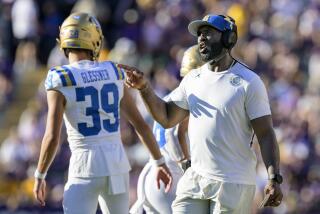UCLA faces a Stanford team well-grounded in the football basics
- Share via
Defensive end Datone Jones assessed the challenge ahead for UCLA’s football team in simple terms.
“They’re just Stanford,” Jones said. “That’s all you need to know.”
Maybe. But you should also know that the Stanford team the Bruins will face Saturday night in Palo Alto has a relatively new approach to doing things.
There was a time when playing Stanford meant chasing after wide receivers while quarterbacks like Jim Plunkett or John Elway threw the ball around for 60 minutes. Tiring, but otherwise not physically taxing.
Facing the sixth-ranked Cardinal (3-0) is now a chore that can leave one sore.
Sure, Stanford has a quarterback in the Plunkett and Elway mold, Heisman Trophy candidate Andrew Luck. But this is now a rough-and-tumble operation. The Cardinal gets rough and opposing teams tend to tumble.
“In the past, Stanford brought to mind throwing the football,” UCLA Coach Rick Neuheisel said. “They have bought into a blue-collar attitude. They landed on an identity.”
Stanford averages 196 yards rushing per game, and the Cardinal has a way of wearing teams down.
The Bruins felt the brunt of that last season in a 35-0 loss. Stanford dominated the line and rushed for 211 yards.
“That’s their calling card,” Neuheisel said. “They have built that mentality. They were more physical than us last year.”
Matt Stevens, who played quarterback at UCLA from 1983-86, remembers a different Stanford philosophy.
“They always had guys who were going to pass the ball and try to outthink you, beat you schematically,” said Stevens, who is now a UCLA announcer. “Now they line up and come at you.”
Thinking is still part of the equation.
Luck is projected as the No. 1 pick in the next NFL draft. He has passed for 786 yards and eight touchdowns in three games. His on-field intelligence, UCLA safety Tony Dye said, is unmatched.
But the Cardinal has plenty of brawn to go with the brains.
The power run game “is who we are and it’s who we have always been. It makes everything else go,” first-year Coach David Shaw said.
Jim Harbaugh installed that philosophy when he became coach in 2007. In 121 seasons of football, Stanford has produced eight 1,000-yard rushers. In his four years, Harbaugh had three of them.
The style nearly put the Heisman Trophy in Toby Gerhart’s hands in 2009. He finished a close second to Alabama’s Mark Ingram.
Even after Gerhart left, the Cardinal rumbled on. Stanford was 17th in the nation in rushing last year, averaging 213.8 yards per game. Stepfan Taylor had 1,137 yards, becoming only the second sophomore in Stanford history to rush for 1,000.
Running backs, though, are merely beneficiaries. The meat of the matter is linemen are beefing up down on The Farm.
“It looks like they moved their dormitory into the weight room,” Stevens said.
Stanford had to replace three starting linemen this season, but it averages 303 pounds along the front and certainly knows how to throw that weight around.
“First and foremost, you have to stop the power run game,” UCLA linebacker Patrick Larimore said. “But Stanford doesn’t just beat you on the ground, they beat you through efficiency.
“They don’t make mistakes. They don’t have penalties. They shift a lot, which gets you out of position.”
UCLA (2-2) has struggled against the run this season. The Bruins held winless Oregon State to 88 yards rushing in a 27-19 victory last week, but Texas had 284 yards in a 49-20 victory a week earlier.
“We’re not a bad defensive line, but we haven’t had the year we’re supposed to have,” Jones said. “That can change. I know these guys are really good and their offensive line is strong. But they’re only human.”
Yes, just Stanford.
twitter.com/cfosterlatimes
More to Read
Go beyond the scoreboard
Get the latest on L.A.'s teams in the daily Sports Report newsletter.
You may occasionally receive promotional content from the Los Angeles Times.











